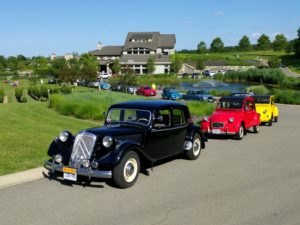2017 CAC Summer Niagara Outing & Hamilton Museum of Steam & Technology Visit

For all that attended the unanimous consensus was that July 8 was a perfect day! For the past few years our summer outings have been to the Niagara region of Southern Ontario. With fruit in season, more wineries opening, and some wonderful rural roads on which to enjoy our Citroëns, it has become a very popular Citroën Autoclub Canada event.
View a full photo gallery of the event here:
This year, rather than trekking all the way to Niagara Falls, we opted to visit The Hamilton Museum of Steam & Technology and then take a leisurely drive along the top of the Niagara Escarpment from Hamilton and visit along the route. CAC member Sietse Elsinga and his wife Petra who live in Beamsville, the heart of Niagara wine country, extended a welcome invitation to all of us for a BBQ dinner at their home, and flourishing greenhouse operation at the end of the day. With that agenda in place all we needed as lovely weather and thankfully we had sunshine and temperatures that while warm, were just cool enough to let us all drive in comfort.
We gathered at Chris Deja’s and John McCulloch’s house in Oakville at 10:00 am and socialized for about an hour before departing and driving by the impressive homes along Lakeshore Rd. as we made our way through Burlington and onto Hamilton where the Museum of Steam & Technology was located right on the Lake Ontario the waterfront.
The complex is located adjacent to Globe Park, with Queen Elizabeth Way to the east and Woodward Avenue to the west. There are several components to the site. The pump house used steam pressure to pump water 3 kms from Lake Ontario to a reservoir above the Niagara Escarpment. The water was distributed to the city of Hamilton through pipes by gravity.
The museum preserves two 70-ton steam engines – the oldest surviving examples in the nation. It is an industrial water works structure built in the Victorian style and a civil and power engineering landmark. A rare example of such a structure in Canada to be “architecturally and functionally largely intact”. Its construction began in 1856, with the work contracted to local stonemason George Worthington, and was completed by 1859. It was opened on September 18, 1860 by Edward VII, at the time the Prince of Wales, during a two-month royal tour to Canada.
The interior of the Italianate pump house building retains its original machinery, floors, and balustrades. Two Cornish engines were originally installed, each one a compound condensing rotative beam engine producing 100 hp and built in Dundas. A massive stone structure was built around each 90-ton, 14-metre (46 ft) engine for support. One of these steam engines still operates, now powered by an electric motor. The 150-foot (46 m) chimney is built of brick atop a large stone base that is over 4 metres thick.
It was formally designated a heritage site on November 17, 1977, and listed as a National Historic Site of Canada on June 12, 2007.
Background:
In 1833, Hamilton’s water system consisted of five wells. A December 1853 report to city standing committee on fire and water, prepared by William Hodgins, proposed a public water system using Ancaster Creek as a source to avoid using pumps or sourcing water from the potentially contaminated Burlington Bay. The committee dismissed the proposal, and in September 1854 announced a public competition to design a public water system suitable for 40,000 inhabitants, about four times the population of the city. A prize of £100 was offered. This was prompted by a cholera epidemic in the city, which killed 552 people in the summer of 1854.
Thomas Keefer was hired to review the submissions, and on December 23, 1854 announced that American engineer Samuel McElroy was the winning candidate. His design included a pumping station at Burlington Heights, and a reservoir near the intersection of York Street and Dundurn Street. Council opted not to build this station, partly encouraged by Keefer whose reports recorded “peculiar” characteristics of the water from Burlington Bay. In January 1857, Hamilton City Council chose Keefer to be chief engineer to build a public water system drawing water from Lake Ontario.
Carla, our impressive tour guide, was able to tell us not only the history but knew the engineeering details of the pumping system in detail. She gave us an in depth lecture that was most fascinating!
With the museum tour over we took the Ridge Rd. along the the edge of Niagara Escarpment affording us a spectacular view of the Hamilton and Toronto in the distance, then dropped down the escarpment near Beamsville and stopped in at Penninsula Ridge Estates Winery, for relaxing afternoon wine tasting an break to sample some delicious cheese trays. From there we ventured back up the escarpment to enjoy some of our favourite twisty roads near Effingham before heading back toward Beamsville and making another stop at Tawse Estates Winery. It was a spectacular setting to end the driving part of our tour and less than 1 km from Petra and Sietse’s place where we jaunted over for the BBQ dinner. Sietse had not only been busy cooking chicken kabobs, sausages and burgers, but managed to make a landmark on the front lawn by placing his 2CV there with the hood propped open with flowers inside and a hay-stuffed mechanic’s suit with shoes laid in the front. Very cute!
We had a wonderful buffet and enjoyed further libations and conversation before bidding adieu and heading back home. It really couldn’t have been a nice day and it was great to see so many members enjoying their classic Citroëns on this fine summer day.

